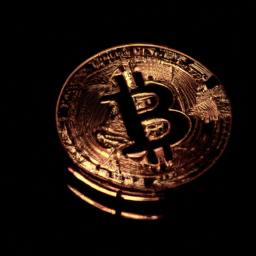
In the world of cryptocurrencies, the question of what a real Bitcoin looks like arises as individuals seek to differentiate between genuine digital currency and counterfeit counterparts. With the surge in popularity and value of Bitcoin, the need for clarity and understanding becomes increasingly important. This article aims to shed light on the distinguishing features and characteristics that define a genuine Bitcoin, providing readers with the knowledge necessary to navigate the complex and evolving landscape of cryptocurrencies.
Read More About Bitcoin And Crypto IRAs Here!
Understanding the Concept of Bitcoin
Explaining bitcoin as a digital currency
Bitcoin, first introduced in 2009 by an anonymous person or group known as Satoshi Nakamoto, revolutionized the concept of currency. Unlike traditional currencies issued by central banks, Bitcoin is a decentralized digital currency, operating independently of any government or financial institution. It is based on a peer-to-peer network, known as blockchain technology, which verifies and records all transactions. Bitcoin is known for its potential to provide a secure, transparent, and borderless method of conducting transactions.
Bitcoin: A product of cryptographic technology
At the heart of Bitcoin lies cryptographic technology. Cryptography ensures the security and integrity of transactions, making it virtually impossible to tamper with or replicate. Bitcoin transactions are encrypted using complex mathematical algorithms, ensuring anonymity and security for both the sender and receiver. This innovative use of cryptography eliminates the need for intermediaries, such as banks, thus reducing transaction costs and processing times.
Bitcoin Appearance: A Misconception
Dispelling the physical appearance myth
Contrary to popular belief, Bitcoin is not a physical coin or note that can be held or touched. It exists solely in a digital form, available in digital wallets and online platforms. This misconception may stem from the term “mining,” which refers to the process of generating new Bitcoins. However, mining involves solving complex mathematical algorithms and does not produce physical coins.
Explaining the non-tangible nature of Bitcoin
Bitcoin is intangible, existing solely as computer code and data. It can be conceptualized as a digital representation of value, much like how traditional currencies are represented digitally in bank accounts. To access and transfer Bitcoin, individuals require digital wallets, which securely store their private keys – encryption codes that provide access to their Bitcoin holdings. These wallets can be accessed through various devices, such as computers or smartphones, enabling users to manage and transact with their Bitcoin holdings.
Digital Representation of Bitcoin
Understanding Bitcoin’s digital footprint
Every Bitcoin transaction is recorded and verified on a public ledger known as the blockchain. The blockchain is a distributed network of computers that work together to validate and store all Bitcoin transactions. A transaction’s digital footprint includes details such as the sending and receiving addresses, the amount of Bitcoin transferred, and a unique transaction ID. This digital footprint provides transparency and allows anyone to trace the history and movement of Bitcoins on the blockchain.
Bitcoin visibility on blockchain technology
The blockchain acts as a transparent and immutable record of all Bitcoin transactions, ensuring the integrity and accuracy of the cryptocurrency. By leveraging blockchain technology, users can verify the authenticity and ownership of Bitcoins, as each transaction is publicly recorded and visible to all participants in the network. This transparency not only enhances security but also facilitates trust between parties involved in Bitcoin transactions.
Physical Tokens: Bitcoin Representations
Role of physical tokens in Bitcoin representation
Although Bitcoin itself is digital, physical representations in the form of tokens do exist. These physical tokens serve as collectibles or novelty items, often minted in limited quantities. They are not the actual Bitcoins used in transactions but rather a physical manifestation of the digital currency. Physical Bitcoin tokens can be made of various materials such as copper, gold, or silver and may feature unique designs. However, it is important to note that their value lies primarily in their collectibility rather than their connection to the digital Bitcoin network.
Examples of physical Bitcoin tokens and their origin
One example of a physical Bitcoin token is the Casascius coin, created by Mike Caldwell. These coins contained embedded private keys, allowing individuals to access the corresponding holdings of actual Bitcoins. However, due to regulatory concerns, Caldwell discontinued the production of these physical coins in 2013. Other examples include commemorative coins or medallions, which feature Bitcoin-related imagery or text. While physical Bitcoin representations can be intriguing and visually appealing, they should not be mistaken for the digital currency itself.
Bitcoin Addresses and Keys
Differentiating public keys, private keys, and addresses
Bitcoin addresses and keys play a crucial role in facilitating storage and transactions. A Bitcoin address is a string of alphanumeric characters that serves as a public identifier for a particular Bitcoin wallet. It is safe to share publicly, allowing others to send Bitcoin to the corresponding wallet. On the other hand, private keys are used to access and control the Bitcoin stored in a wallet. They must be kept confidential and secure to prevent unauthorized access or theft. Private keys are mathematically linked to their corresponding Bitcoin addresses, allowing users to sign transactions and prove ownership of the associated Bitcoins.
The role of keys and addresses in Bitcoin storage and transactions
When someone sends Bitcoin to a specific address, the transaction is recorded on the blockchain. To spend or transfer those Bitcoins, the recipient must use their private key to sign the transaction, proving their ownership and authorizing the transfer. The private key acts as a digital signature, ensuring the transaction’s validity and authenticity. Therefore, Bitcoin addresses and keys are essential components for securely storing and transacting with Bitcoins.
Visualization of Bitcoin Transactions
Understanding Bitcoin transaction process
Bitcoin transactions involve the transfer of value from one Bitcoin address to another. When a transaction occurs, it is “broadcasted” to the network, where it awaits verification by miners. Miners verify the transaction’s validity by solving complex mathematical puzzles, ensuring that the sender has sufficient funds and the transaction adheres to the rules of the Bitcoin network. Once the transaction is verified, it is added to a block in the blockchain, becoming a permanent record of the transaction history.
Following a Bitcoin transaction on the blockchain
To track a Bitcoin transaction on the blockchain, individuals can use blockchain explorers – online tools that allow users to search for and view specific transactions. By entering the transaction ID or the associated Bitcoin addresses, users can access detailed information about the transaction, including the amount transferred, the date and time of the transaction, and the wallet addresses involved. This transparency ensures accountability and trust in the Bitcoin network, as all transactions can be audited and verified by anyone.
Bitcoin Wallets: Holding Bitcoin
The function of Bitcoin wallets
Bitcoin wallets are digital tools that enable users to store, manage, and transact with their Bitcoin holdings. They provide a secure environment for users to control their private keys, allowing them to send and receive Bitcoins. Bitcoin wallets come in various forms, including software wallets (installed on computers or smartphones) and hardware wallets (physical devices that store private keys offline). Regardless of the type, Bitcoin wallets are crucial for the safekeeping and accessibility of Bitcoin.
Different types of Bitcoin wallets: Online and offline variants
Online or web-based wallets are accessible through web browsers or mobile apps. They offer convenience and easy accessibility, allowing users to manage their Bitcoin holdings from any internet-connected device. However, online wallets may be more vulnerable to hacking or other security risks, as they rely on internet connectivity and may store private keys on servers controlled by third parties.
In contrast, offline wallets, such as hardware wallets or paper wallets, store private keys offline, away from potential online threats. Hardware wallets are physical devices that generate and store private keys, providing an extra layer of security. Paper wallets, on the other hand, involve creating a physical printout or writing down the private keys on paper. These offline wallet options significantly reduce the risk of online attacks but require users to take extra precautions to protect physical storage mediums.
What Makes Each Bitcoin Unique
Exploring non-duplication and uniqueness of each Bitcoin
One of the fundamental properties of Bitcoin is its scarcity. Unlike traditional currencies that can be printed or created at will, the total supply of Bitcoins is limited to a predetermined maximum of 21 million coins. Each Bitcoin is uniquely identified by its transaction history and cryptographic signatures, making them distinguishable from one another. This uniqueness ensures the scarcity and value of each Bitcoin.
Understanding the role of Bitcoin mining in generating unique Bitcoins
Bitcoin mining is the process by which new Bitcoins are created and added to the circulating supply. Miners compete to solve complex mathematical puzzles, and the first miner to solve the puzzle is rewarded with newly generated Bitcoins. This process adds new Bitcoins to the network while ensuring their uniqueness and originality. As the mining difficulty increases over time, the creation of new Bitcoins becomes progressively challenging, further cementing their uniqueness and scarcity.
Common Misunderstandings About Bitcoin’s Appearance
Addressing misconceptions about Bitcoin’s look
Due to its digital nature, Bitcoin does not have a physical appearance. It cannot be held, touched, or physically exchanged like traditional currencies or commodities. Bitcoin exists solely in the form of electronic data stored on the blockchain. This misconception may arise from the representation of Bitcoin using physical tokens or novelty items, which do not accurately represent the digital currency itself.
The impact of media representation on Bitcoin image perception
Media representations of physical Bitcoin tokens or coins may lead to misconceptions about Bitcoin’s appearance. News or images portraying physical representations may inadvertently create the impression that Bitcoin has a physical form. It is important to separate the concept of physical representations from the underlying digital nature of Bitcoin to prevent confusion and misunderstanding.
The Reliability and Security of Bitcoin
Exploring the security mechanisms of Bitcoin
Bitcoin’s security relies on various mechanisms, making it a reliable and robust digital currency. As a decentralized network, Bitcoin uses consensus algorithms to validate transactions and secure the blockchain. Through cryptographic hashing, all transactions are linked together, creating an interconnected chain of blocks that is computationally secure. The decentralized nature of the network also means that there is no single point of failure, making it more resilient to attacks or disruptions.
How trust is established with Bitcoin use
Trust is established in the Bitcoin network through consensus and cryptographic principles. The decentralized nature of the network ensures that no single entity has control over the currency or its transactions, fostering trust among participants. Additionally, the transparency of the blockchain allows anyone to verify and audit transactions, ensuring the accuracy and integrity of the system. By eliminating the need for intermediaries and relying on cryptographic principles, Bitcoin provides a trustless and secure method of conducting transactions.
